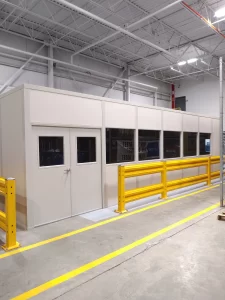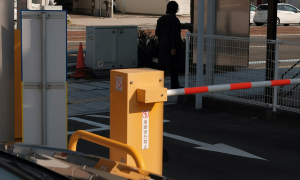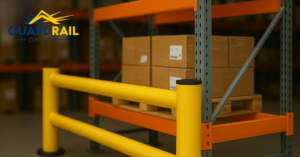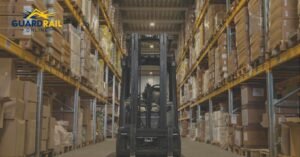If you have ever shopped for industrial safety guard rails, chances are you’ve come across specifications like “10,000 lb at 4 mph.”
At first glance, it sounds precise and reassuring, almost like a guarantee. But pause for a moment! Does that number actually matter in your facility? Should you really invest more in a 10,000 lb impact guard rails just because the spec sheet claims it can stop a 10,000-pound load at a given speed? These are not routine questions, these are in fact very important queries. Moreover, these labels very often create more confusions than clarity for many safety managers.
The reality is that such ratings for a warehouse guard rails are not marketing jargon. They come from controlled tests that simulate how a loaded forklift might collide with a barrier. However, the meaning of these tests and how closely they match your real-world conditions is not always obvious.
This article is going to lay out the physics, the testing standards, and the functional implications behind these numbers. It also intends to help you evaluate guardrail systems with confidence, avoid misleading assumptions, and make smarter, safer investments for your facility.
What does “10,000 lb at 4 mph” actually mean?
Have you every wondered what the vendors are really promising when they state that their industrial safety guard rails are rated 10,000 lb at 4 mph?
Simply put, they mean that their industrial safety guard rails were designed and tested to stop or deflect a typical loaded forklift in a controlled test. But how do they really ensure what load a forklift can bear? They basically run tests that use a surrogate mass and a set speed to carry out such assessments. The mass of surrogate test vehicle used in such situations is near 10,000 pounds. While the speed of the same surrogate vehicle is near 4 miles per hour.
The goal of such assessments is to evaluate whether the industrial safety railing systems will hold in place, bend safely, and keep people and assets protected. It is however important to note that this is not a guarantee of survival in every real collision. Instead, it actually provides a consistent benchmark for comparison.
A real forklift in your industrial space may weigh less or even more than the test surrogate. It may even hit at a different speed or at an very different angle. Those differences, even relatively small, can indeed change results. That is why it is highly important that you must read a vendor’s test method, not only the headline rating. Some companies test their industrial safety guard rails to similar parameters and report the same 10,000-lb label. Others on the contrary may use different rigs or methods. So, it is always better to check the test report before you make an investment into systems that claim to be a 10,000 lb impact guard rails.
It’s helpful to look at how some guardrail systems are designed and tested to understand what the “10,000 lb at 4 mph” label actually represents. Many of these industrial safety guard rails especially those claiming this rating are built using bolted, modular parts and strong, reinforced support posts. These components are not just meant to block an impact. They are carefully engineered to bend slightly, absorb the force, and still stay standing, preventing damage to people, equipment, or infrastructure.
Companies like Guardrail Online, among others, often share detailed test reports that outline how their safety barriers performed under controlled impact conditions. These tests typically use a surrogate vehicle or weight of 10,000 pounds moving at 4 miles per hour, which is often a stand-in for a loaded forklift. The published results from such companies allow you to compare different products on an even playing field. Such results help understand which systems often held up best under identical testing scenarios.
How does the physics behind guardrail impact really work?
Behind every impact rating lies a simple physics principle known as the kinetic energy. This is actually the energy of motion. The faster something moves, or the heavier it is, the more energy it carries into a collision. What often surprises facility managers is how quickly this energy increases with speed.
It’s what gives a moving object the power to cause damage on impact. Both speed and weight play a role here. In fact, the heavier an object is, or the faster it’s moving, the more energy it brings into a collision. The actually problem is that energy doesn’t just disappear on impact, it actually has to go somewhere.
In real-world terms, that energy is transferred into whatever the moving object hits — in this case, an industrial safety guard rails. The more kinetic energy involved, the harder that force tries to push through or deform the barrier. This can result in anything from a slight bend to a complete failure of the system if it’s not properly rated for that level of impact. That’s why even a modest increase in speed or load can significantly change the outcome. This means a forklift moving just a little faster can generate far more force than expected. Such a force can potentially overwhelm an industrial safety guard rail that would have otherwise held strong, significantly change the outcome of an impact.
For example, take the industry-standard label: “10,000 lb at 4 mph.” This represents a specific level of impact energy that the guardrail has been tested to absorb. If the speed is doubled to 8 mph, the impact energy increases dramatically. IT does not just double, but roughly quadrupled. In contrast, increasing the weight (mass) often has a more gradual, linear effect.
So, what does this mean for your safety planning?
It doesn’t mean your heavy duty industrial guard rail is insufficient. In fact, a 10,000 lb at 4 mph rating is a strong and reliable benchmark that is proven through standardized, controlled testing. What it does mean is that real-world conditions matter. A guardrail designed to handle certain impacts will perform best when used in environments that match those conditions.
That’s why your best approach to ensure safety should combine two things:
- Traffic management—ensuring forklifts and vehicles operate at safe, predictable speeds.
- Properly rated barriers—engineered to absorb and deflect energy within tested limits.
When you control the environment and choose the right protection, you’re not just checking a box. You are actually making sure your industrial safety guard rails work as expected.
How are impact ratings actually tested and what should you look for?
For a long time, one of the biggest challenges in the world of industrial safety guard rails was the lack of consistency in testing. Every manufacturer had their own way of proving product strength. These were often done using different test rigs, surrogate weights, impact angles, and even reporting formats. As a result, comparing one forklift safety rail to another was like comparing apples to oranges. Buyers were left guessing which product truly offered better protection.
Fortunately, the industry has made major strides toward solving this problem. Thanks to the introduction of ANSI MH31.2, a standardized testing method developed by the Protective Guarding Manufacturers Association (ProGMA). This standard lays out clear, consistent guidelines for how industrial safety guard rails should be tested. The standard includes defined impact weights and speeds, as well as the proper conditions under which tests must be run.
In addition to following ANSI MH31.2, reputable vendors now go a step further by using ISO/IEC 17025-accredited laboratories. These are facilities that meet international standards for technical competence and data integrity. This adds another layer of confidence, ensuring that results are not only consistent, but also scientifically valid and independently verified.
So, when evaluating industrial safety railing systems, don’t rely solely on the headline rating, even if it says “10,000 lb at 4 mph.” That number is only part of the story. Always ask to see the full test report, and look for specific details such as:
- The surrogate mass and speed used in testing.
- Whether the system was struck multiple times or only once.
- Deflection values and how far the barrier moved on impact.
- Confirmation that testing was done under ANSI MH31.2 or by an accredited lab.
These details matter because some vendors may publish ratings without independent verification. By asking for reports and certifications, you separate engineered solutions from marketing claims. After all, a true safety investment is backed by transparent testing, not vague promises.
Is a 10,000-lb Impact Rated Guardrail Right for Your Facility?
Not every facility needs the most heavy-duty barrier on the market — and that’s perfectly okay. A “10,000 lb at 4 mph” rating is a powerful benchmark, but whether it’s the right choice depends on the risks unique to your environment.
If your operation involves frequent forklift traffic, especially in manufacturing plants, distribution hubs, or large warehouses, then this rating may be essential. These forklifts often weigh close to or more than 10,000 pounds when fully loaded. In such settings, 10,000 lb impact guard rails help protect not just equipment, but also your people and operational continuity.
The same holds true for facilities storing sensitive equipment, critical infrastructure, or hazardous materials. In these cases, even a minor breach could result in costly downtime or serious safety hazards. This makes installing higher impact resistant barriers not just smart, but necessary.
But what if your site doesn’t see that kind of traffic?
Do you manage or own areas with low-speed or low-weight environments? These may include spaces like packaging facilities, retail stockrooms, or assembly areas with pallet jacks and hand carts. Such areas can stay protected even when you use lighter industrial safety guard rails. Not only might they cost less, but still offer the protection you need. After all, at the end of the day, It’s not about buying the strongest option. Instead, it is actually centered around buying the right one for the job.
To help assess what’s right for your operation, ask:
- What types of vehicles operate here, and how fast do they typically move?
- How close are workers, assets, or machinery to those traffic zones?
- Are you more likely to experience small bumps often, or rare but severe impacts?
The answers will guide you toward a smarter investment, whether that’s going to be 10,000-lb industrial safety guard rails or a different rated solution tailored to your real-world needs.
Conclusion
Understanding what “10,000 lb at 4 mph” truly means reshapes the way you evaluate guardrail systems. It’s not just a number stamped on a brochure — it’s a carefully measured benchmark, the result of standardized testing designed to simulate real-world forklift impacts. When used correctly, it becomes a valuable tool for comparing products and making informed decisions.
But the number alone isn’t the full story. The real power lies in digging deeper. This includes reviewing the actual test data, verifying compliance with recognized standards like ANSI MH31.2, and assessing whether those tested conditions align with your facility’s unique realities. That’s the difference between buying into a marketing claim and making a reliable safety investment.
At the same time, it’s crucial to remember that industrial safety guard rails are only one part of a complete safety ecosystem. A truly effective solution integrates traffic management, operator training, and thoughtful facility layout all working together to prevent collisions in the first place. When you combine engineered 10,000 lb impact guard rails with proactive safety planning, you’re not just installing barriers — you’re building resilience into your operations.
At Guardrail Online, we design and supply engineered industrial guardrail systems that are tested to rigorous standards, documented with transparent results, and built for long-term performance. When you choose us, you are choosing more than industrial safety guard rails—you are choosing a proven partner in workplace safety.





